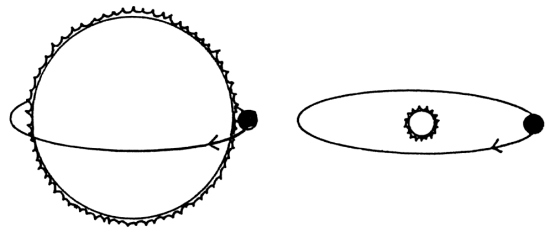Since publication of this article in 1980, studies of the sun’s size have yielded different results. Currently, scientists are not united enough concerning any broadscale trends to support age estimates based on the size of the sun. In his 1998 article "The Young Faint Sun Paradox and the Age of the Solar System," Dr. Danny Faulkner provided an updated perspective that is more consistent with the relevant solar data. Other studies do provide ample evidence for the youth of the solar system and earth, such as the studies cited in the Evidence section Many Earth Clocks Indicate Recent Creation.

OBSERVATIONS
Does the size of the sun change over the years? Recently, "John A. Eddy (Harvard -Smithsonian Center for Astrophysics and High Altitude Observatory in Boulder) and Aram A. Boornazian (a mathematician with S. Ross and Co. in Boston) have found evidence that the sun has been contracting about 0.1% per century…corresponding to a shrinkage rate of about 5 feet per hour."1 The diameter of the sun is close to one million miles, so that this shrinkage of the sun goes unnoticed over hundreds or even thousands of years. There is no cause for alarm for us or for any of our descendants for centuries to come because the sun shrinks so slowly. Yet the sun does actually appear to shrink. The data Eddy and Boornazian examined spanned a 400-year period of solar observation, so that this shrinkage of the sun, though small, is apparently continual.
INTERPRETATION
What does the shrinkage of the sun have to do with creation and evolution? The sun was larger in the past than it is now by 0.1% per century. A creationist, who may believe that the world was created approximately 6 thousand years ago, has very little to worry about. The sun would have been only 6% larger at creation than it is now. However, if the rate of change of the solar radius remained constant, 100 thousand years ago the sun would be twice the size it is now. One could hardly imagine that any life could exist under such altered conditions. Yet 100 thousand years is a minute amount of time when dealing with evolutionary time scales.2
How far back in the past must one go to have a sun so large that its surface touches the surface of the earth? The solar radius changes at 2.5 feet per hour, half the 5 feet per hour change of the solar diameter. The distance from the sun to the earth is 93 million miles, and there are 5,280 feet in one mile. Assuming (by uniformitarian-type reasoning) that the rate of shrinkage has not changed with time, then the surface of the sun would touch the surface of the earth at a time in the past equal to
| t = | (93,000,000 miles) (5,280 ft/mile) |
| (2.5 ft/hr) (24 hr/da) (365 day/yr) |
or approximately 20 million B.C. However, the time scales required for organic evolution range from 500 million years to 2,000 million years.3 It is amazing that all of this evolutionary development, except the last 20 million years, took place on a planet that was inside the sun. By 20 million B.C., all of evolution had occurred except the final stage, the evolution of the primate into man.
One must remember that the 20 million year B.C. date is the extreme limit on the time scale for the earth's existence. The time at which the earth first emerged from the shrinking sun is 20 million B.C. A more reasonable limit is the 100 thousand year B.C. limit set by the time at which the size of the sun should have been double its present size.
A further word of explanation is needed about the assumption that the rate of shrinkage of the sun is constant over 100 thousand years or over 20 million years. The shrinkage rate centuries ago would be determined by the balance of solar forces. Since the potential energy of a homogeneous spherical sun varies inversely with the solar radius, the rate of shrinkage would have been greater in the past than it is now. The time at which the sun was twice its present size is less than 100 thousand B.C. The time at which the surface of the sun would touch the earth is much less than 20 million B.C. Therefore, the assumption of a constant shrinkage rate is a conservative assumption.
SOLAR ENERGY
The shrinkage of the sun greatly alters what we believe to be the energy source within the sun. The sun shrinks because of its own self-gravitational attraction. As it compresses itself, it heats itself. This heat is then liberated in the form of solar radiation, i.e., sunlight.
Would a 2.5 feet per hour contraction of the solar surface be sufficient to liberate all of the energy that comes from the sun? A crude estimate can be made by assuming the interior of the sun is uniform. The known formula4 for the gravitational potential energy of two masses m and M a distance r apart is U = - GmM/r, where G = 6.6 x 10-11jm /kg2. The gravitational potential energy of the sun's mass Ms interacting with its own mass Ms is U= - Gms2/R, where R is the radius of the sun. The solar power produced as the sun shrinks at the rate of v = R/t is5 P = U/t = (Gms2/R2) . (R/t) = GMs2v/R2. The mass of the sun is 2 x 1030kg, the radius of the sun is 7 x 108 m, and the 2.5 feet/hour rate of shrinkage in the radius of the sun is 2 x 10 -4 m/sec. in metric units. The power formula gives a potential solar power of 1 x 1029 watts. This potential gravitational power is hundreds of times more than the 4 x 1026 watts of power actually produced by the sun. This figure is an overestimate because the sun is actually far from uniform. The massive interior of the sun is protected by the outer layers of the sun. Only those low density outer layers are thought to contract. Even so, there is plenty of gravitational contraction energy potentially available to account for all or a large part of the sun's energy.
STELLAR EVOLUTION SHAKEN
One thing is certain. Some of the sun's energy comes from its gravitational self-collapse. Therefore, not all of this energy comes from thermonuclear fusion. This discovery greatly alters all calculations on the evolution of the sun, because all of those calculations attribute practically 100% of the sun's energy over the past 5 billion years to thermonuclear fusion. The discovery that the sun is shrinking may prove to be the downfall of the accepted theory of solar evolution. All accepted theories of the evolution of the stars are based on the assumption that thermonuclear fusion is the energy source for the stars. If this assumption is unjustified for our own star, the sun, it is unjustified for the other stars too. The entire theoretical description of the evolution of the universe may be at stake. With the stakes that high, it is no wonder that the experimental evidence for the shrinkage of the sun is "explained away" by evolutionists. Evolutionists claim that the sun probably undergoes temporary shrinkages and expansions as small fluctuating oscillations on its overall regular evolutionary development.6 They point to other cyclic solar occurrences such as the 11-year sunspot cycle on the surface of the sun. This claim is made in spite of the evidence that the shrinkage rate of the sun has remained essentially constant over the past 100 years when very accurate measurements have been made on the size of the sun. Less accurate astronomical records spanning the past 400 years indicate the shrinkage rate has remained the same for the past 400 years.
HISTORICALLY SPEAKING
Scientists have not always attributed the energy source of the sun to thermonuclear fusion. Prior to the discovery of thermonuclear fusion, Helmholtz predicted that the energy of the sun was supplied by the gravitational collapse of the sun.7 This model was accepted until the theory of evolution began to dominate the scientific scene. Then Helmholtz's explanation was discarded because it did not provide the vast time span demanded by the theory of organic evolution on the earth. The substitute theory was introduced by Bethe in the 1930's precisely because thermonuclear fusion was the only known energy source that would last over the vast times required by evolution. Science may now be on the verge of disproving the substitute evolutionary model of the sun.
CONCLUSION
The change in the size of the sun over the past 400 years is important in the study of origins. Over 100 thousand years these changes would have accumulated so much that life of any kind on the earth would have been very difficult, if not impossible. Thus, all life on the earth must be less than 100 thousand years old. The sun, 20 million years ago, would have been so large that it would have engulfed the earth. The earth cannot be more than 20 million years old. Those dates as upper limits rule out any possibility of evolution requiring hundreds of millions of years. However, the tiny change that would have occurred in the sun during the Biblical time since creation would be so small as to go almost unnoticed. Thus, the changes in the sun are consistent with recent creation.
The changes detected in the sun call into question the accepted thermonuclear fusion energy source for the sun. This, in turn, questions the entire theoretical structure upon which the evolutionary theory of astrophysics is built.
REFERENCES
1 Lubkin, Gloria B., Physics Today, V. 32, No. 9, 1979.
2 Ordway, Richard J., Earth Science and the Environment, New York: D. Van Nostrand, 1974, p. 130. Fig. 5 - 23 on this page gives a good illustration of the accepted evolutionary time scale.
3 Scientific American, V. 239, No. 3, 1978. All articles in this edition list the various evolutionary time scales.
4 Halliday, David and Resnick, Robert, Fundamentals of Physics, New York; Wiley, 1974, Chapter 14.
5 The exact formula must be derived layer by layer using integral calculus. The result is identical to the formula listed, except that it contains an additional factor. The additional factor is so close to unity that it makes little difference in an estimation.
6 Lubkin, pg. 18.
7 Poppy, Willard J. and Wilson, Leland L., Exploring the Physical Sciences, Englewood Cliffs: Prentice Hall, 1973, P. 324.
* Dr. Akridge earned his B.S., M.S., and Ph.D. degrees in physics from Georgia Tech. He earned the Th.M. degree from the New Orleans Baptist Theological Seminary. Dr. Akridge is an Assistant Professor of Physics at Oral Roberts University. He has written several articles in the Creation Research Society Quarterly in which he shows that the laws of physics support a recent creation. [Dr. Akridge and his wife, Anita, have two children, Floyd and Sheryl. They live in Tulsa, Oklahoma.]
Cite this article: Akridge, R. 1980. The Sun Is Shrinking. Acts & Facts. 9 (4).


















